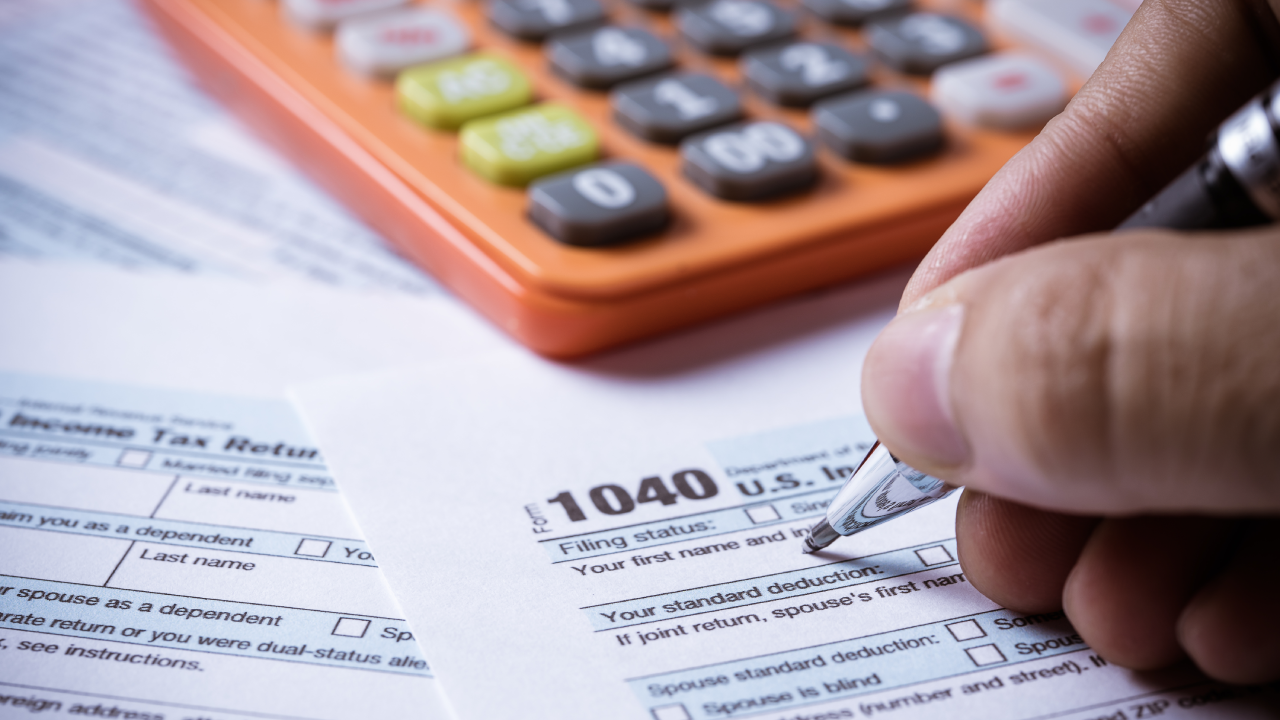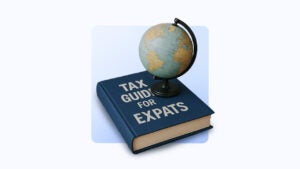1040 form: What it is, how to fill it out



If you’ve ever paid money to Uncle Sam, you’re probably familiar with Form 1040. The 1040 is the foundation of tax filing in the U.S. and, along with various accompanying schedules and supporting forms, is where you calculate whether you owe money to the IRS or will get a tax refund.
Key takeaways
- Form 1040 is the standard form taxpayers must fill out every year to report their income and claim tax credits and deductions.
- You’ll need to fill out the 1040 form if you’re a U.S. citizen or permanent resident and your income meets a certain threshold.
- There are several ways you can file Form 1040, including for free through the IRS or via tax filing software.
What is the 1040 tax form?
The 1040 tax form is the main IRS form that U.S. taxpayers must fill out every year come tax season. Known as the “Individual Income Tax Return,” this standard form is where taxpayers report their income and claim tax credits or deductions. The form will help you calculate how much of your income is taxable and how much you owe the federal government or how much you’ll get back as a tax refund.
Each year, the IRS releases a revised Form 1040. It tends to look similar from one year to the next, with small changes such as adjustments for inflation or instructions relevant for any tax code changes.
In addition to the standard Form 1040, there are five other types of 1040 form: 1040-X, 1040-NR, 1040-SR, 1040-V and 1040-ES (more on these below).
Who needs to file Form 1040?
If you’re a U.S. citizen or permanent resident and your income meets a certain threshold, you likely need to file a tax return, also known as a 1040 form.
Income thresholds
These are the income thresholds for filing a tax return for tax year 2024 (returns filed in 2025). These thresholds are adjusted every year.
| Filing status | Younger than 65 | 65 or older |
|---|---|---|
| Single | $14,600 | $16,550 |
| Head of household | $21,900 | $23,850 |
| Married filing jointly | $29,200 (both spouses under 65) | $30,750 (one spouse over 65) $32,300 (both spouses over 65) |
| Qualifying surviving spouse | $29,200 | $30,750 |
| Married filing separately | $5 | $5 |
Keep in mind that even if your income is below these thresholds, you may still want to file a return so you can collect a refund of taxes your employer withheld from your paychecks, or to claim any refundable credits for which you may be eligible, such as the earned income tax credit or additional child tax credit.
If you’re a dependent, the rules are different. The type of income — earned or unearned — plays into whether you need to file.
How to fill out Form 1040
Many taxpayers use tax filing software, such as H&R Block or TurboTax, which will guide you through filling out the 1040 by asking you questions and auto-populating the form for you. But there are five different ways to file your taxes online for free in 2025, so it makes sense to see if you qualify for one of the free options. Finally, if you want to truly DIY the process, you can find the latest version of Form 1040 on the IRS website, download it, fill it out and send it in via snail mail.
Whatever method you choose for filing your taxes, it can help to look at the Form 1040 to get a sense of what type of information you’ll need on hand to complete your tax return. Here’s a quick rundown of how to fill out the 1040 form.
Provide personal information
At the top of the form, you’ll need to fill out your basic information, including your name, address, Social Security number and filing status (such as single, head of household or married filing jointly). If you’re filing jointly, you’ll need to include your spouse’s full name and Social Security number as well.
Report income
The amount of tax you owe depends on your income, and this section of the form is where you identify that taxable income. If you have an employer who withholds taxes from your paycheck, you’ll need to include the income found on the W-2 form your employer issued to you. Other types of income include money made from tips that are not included in your W-2, IRA distributions, Social Security benefits and more.
There’s also a section on the 1040 that asks about any digital assets received, such as cryptocurrency. Meanwhile, for some other types of income, you may need to fill out other forms, such as Schedule E for rental real estate income and Schedule C for self-employment income. Generally, the information from those forms then gets added to Schedule 1, “Additional Income and Adjustments to Income,” and then that information flows to the 1040 form.
Claim deductions
Next, it’s time to claim your deductions, which can lower your income and thus decrease your overall tax burden. You’ll start with what are called “above-the-line” deductions — named as such because they appear above the line that calculates your adjusted gross income (AGI).
If you qualify for any of these deductions, you’ll need to fill out Schedule 1. Above-the-line deductions include deductions for IRA contributions, health savings account (HSA) contributions, student loan interest payments and more. You can use “above-the-line” deductions to lower your income whether you claim the standard deduction or itemize your deductions.
Next, you’ll have to choose between itemizing your deductions and taking the standard deduction on line 12 of the 1040 form.
Generally, you’ll want to itemize if the total of your itemized deductions adds up to more than the standard deduction. However, the amount of the standard deduction was almost doubled by the Tax Cuts and Jobs Act of 2017, which is why fewer than 10 percent of tax filers find itemizing worthwhile. If you do choose to itemize, you’ll need to fill out Schedule A.
After subtracting your itemized deductions or the standard deduction (and possibly the qualified business income deduction if you’re eligible for it) from your income, you end up with your taxable income on line 15 of the 1040 form.
Calculate tax
Starting with line 16 on Form 1040, you’ll fill in your taxes owed, based on your taxable income from line 15. The amount you owe is based on the federal tax brackets.
For additional taxes, such as self-employment tax or Social Security and Medicare tax on unreported tip income, you’ll need to fill out Schedule 2.
Claim tax credits
Next, you can claim any tax credits you’re eligible for that will reduce your liability.
Some tax credits, including the child tax credit, are included on Form 1040 while others require you to fill out and attach Schedule 3.
More tax owed or refund due?
Once you’ve reduced your taxes owed by any tax credits, the 1040 form asks you to fill in the amount of any taxes you already paid throughout the year, such as taxes that were withheld from your paycheck or any estimated tax payments you made.
Then you calculate whether you owe more money or can expect a tax refund. If you’re owed a refund, the 1040 form has a section for entering direct-deposit information, which the IRS says is the fastest way to get your tax refund.
How to file Form 1040
Most people file their taxes online, but there are different ways of doing that. Four ways to file your taxes online are:
- IRS Fillable Forms: You can use the IRS’ free file fillable forms, which is essentially an online app for filling out your tax forms. These forms are free and similar to filling them out by hand, but you’ll be doing it electronically. This option makes sense if you’re confident about your ability to complete your tax return without guidance.
- IRS Free File: For its Free File program, the IRS partners with tax software companies to offer free access to tax software. In 2024, you can use it if you have an AGI of $84,000 or less.
- IRS Direct File: This is the IRS’ own online tax-preparation software. Direct File supports only a few tax deductions and credits, and is available in 25 states currently.
- Tax software programs: The best tax software — such as H&R Block, TurboTax and TaxSlayer — will ask you to fill out your information in a question-and-answer format and then fill out your forms and file your taxes for you, usually for a fee.
Other types of Form 1040
Most U.S. taxpayers will use Form 1040 as their tax return. But there are other 1040 forms to consider:
- Form 1040-X: If you need to amend a previously filed return, use Form 1040-X.
- Form 1040-NR: If you’re a nonresident alien with a business in the U.S., you may need to fill out Form 1040-NR.
- Form 1040-SR: Taxpayers age 65 or older can use Form 1040-SR in place of the regular 1040. The 1040-SR is essentially the same as the 1040 but with a bigger font and more clarity around the extra standard deduction amounts for people aged 65 or older.
- Form 1040-V: If, once you complete your tax return, it turns out that you owe the IRS money, the 1040-V is the form you send with your payment, and with your 1040 form, to the IRS.
- Form 1040-ES: If you need to pay tax on income that’s not subject to withholding, such as if you’re self-employed, you’ll need to make quarterly estimated payments via Form 1040-ES.
Why we ask for feedback Your feedback helps us improve our content and services. It takes less than a minute to complete.
Your responses are anonymous and will only be used for improving our website.



